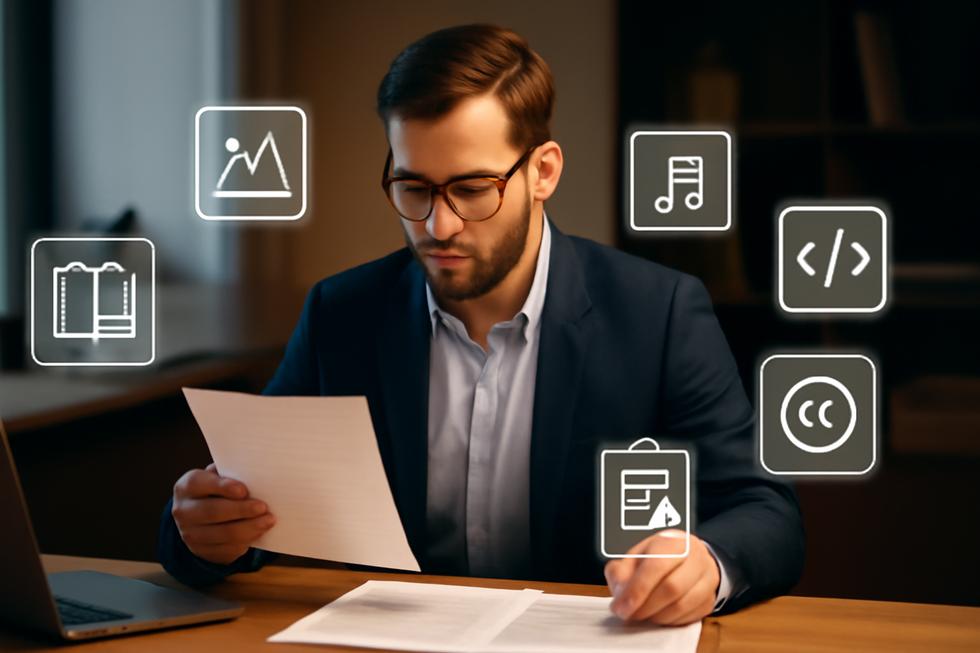Introduction
For business owners, intellectual property is a cornerstone of competitive advantage and brand strength. Among IP protections, copyright plays a crucial role in safeguarding original creative works and managing how they are shared or monetized. Recognizing the different forms copyright takes—from the types of protected works, to the layered licensing mechanisms—empowers businesses to make informed decisions about their assets. This guide explores the core categories of copyright protection, the licensing frameworks that govern usage rights, how exclusive and non-exclusive licenses differ, and the roles Creative Commons and Copyleft licenses play in today’s digital ecosystem. By understanding each of these aspects, business owners can better protect their innovations while maximizing value through appropriate sharing and licensing agreements.
Tables of Contents
Chapter 1: Different Forms of Copyright in Protected Works
- Understanding Copyright Protection for Literary and Musical Creations
- Protecting Creativity in Visual and Audiovisual Works: Understanding Copyright’s Reach
- Distinct Protections for Software and Architectural Creations in Copyright Law
- Understanding Legal Rights and Duration in Various Copyrighted Works
Chapter 2: Different Forms of Copyright in Licensing Mechanisms
- Harnessing Technology in Licensing: Software Protection and Digital Rights Management
- Exclusive vs. Non-Exclusive Licenses: Economic Impacts and Market Dynamics in Copyright Licensing
- Navigating Compulsory and Statutory Licensing: Legal and Geopolitical Dynamics in Copyright
- Navigating Copyright Licensing’s Societal Role: Access, Cultural Flow, and Public Benefit
Chapter 3: Navigating Copyright Licensing: Exclusive and Non-Exclusive Rights in Creative Works
- How Technological Advances Shape Exclusive and Non-Exclusive Copyright Licensing
- Economic Dynamics Behind Exclusive and Non-Exclusive Copyright Licenses
- Global Dynamics Shaping Exclusive and Non-Exclusive Copyright Licenses
- How Exclusive and Non-Exclusive Copyright Licenses Shape Creativity, Access, and Economy
Chapter 4: The Role of Creative Commons and Copyleft Licenses in Modern Copyright Frameworks
- Technological Insights into Creative Commons and Copyleft Licensing Models
- Balancing Innovation and Incentives: Economic Effects of Creative Commons and Copyleft Licensing
- Global Legal Landscapes and Geopolitical Impact of Creative Commons and Copyleft Licensing
- How Creative Commons and Copyleft Shape Cultural Sharing and Innovation
Chapter 1: Different Forms of Copyright in Protected Works
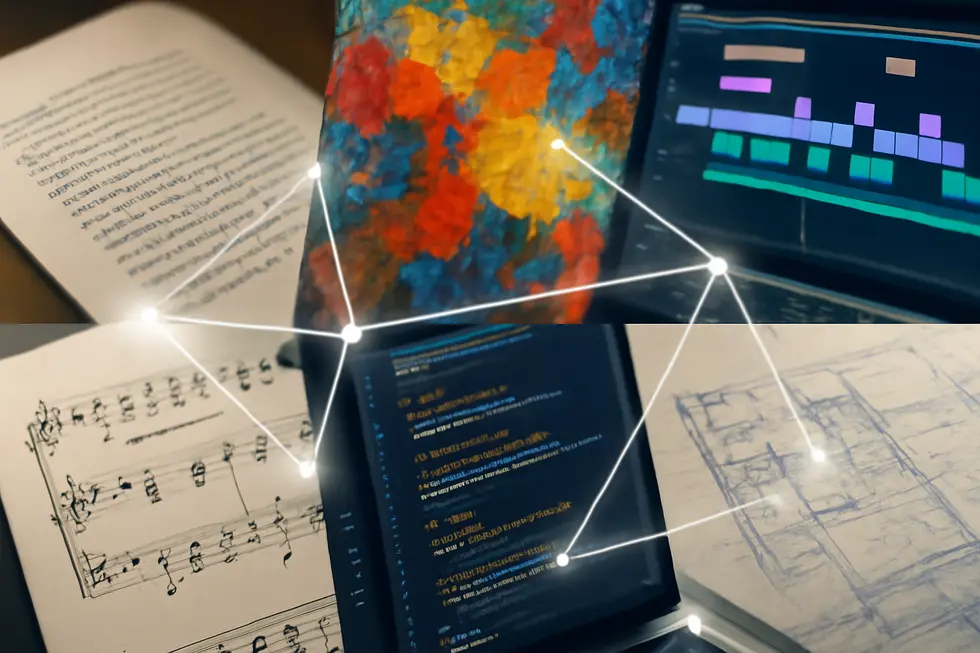
1. Understanding Copyright Protection for Literary and Musical Creations
Copyright law safeguards literary and musical creations as distinct categories of original works fixed in tangible forms, each governed by specific protections and rights. Literary works encompass a broad spectrum—from novels, poems, and articles to computer programs—expressed through words, numbers, or other symbolic representations. Protection arises once these works are fixed, meaning they are captured in a form perceptible and reproducible, such as manuscripts or digital files. The originality criterion requires the work to be independently created with at least minimal creativity, excluding pure facts or copied material.
Musical works, meanwhile, cover compositions like songs and instrumental pieces, including lyrics, distinct from sound recordings, which are separately protected. These compositions must be similarly fixed, for example, in sheet music or audio formats. Copyright grants exclusive rights to reproduce, distribute, perform (notably for musical works), publicly display (more relevant to literary works), and create derivative works based on the original.
Both categories share a typical duration of protection lasting the life of the author plus 70 years, under U.S. law. This framework ensures creators retain control over how their works are used and disseminated without requiring formal registration, although registering can enhance legal enforceability. By understanding these nuances, creators and users alike can better navigate the scope of permissible use and licensing.
For those interested in detailed copyright implications for literary creations, further resources on copyright information for books provide valuable insights.
Reference: U.S. Copyright Office, Copyright Basics Overview.
2. Protecting Creativity in Visual and Audiovisual Works: Understanding Copyright’s Reach
Protecting Creativity in Visual and Audiovisual Works
Copyright safeguards a wide array of visual and audiovisual creations, recognizing the unique nature of each medium. Visual works, such as paintings, photographs, and graphic designs, represent original artistic expressions fixed in a tangible form. These static pieces are protected not only for their originality but also through moral rights—such as attribution and integrity—ensuring artists retain control over how their works are credited and altered, as outlined in Section 106A of the Copyright Act of 1976.
In contrast, audiovisual creations blend moving images with sound, encompassing films, videos, and presentations. These complex works protect various components, including scripts, performances, and music, collectively forming a single copyrightable entity. Protection starts from fixation in a tangible medium, which can be digital files or physical reels, similarly requiring originality and permanence.
Both types share foundational copyright requirements: independent creation accompanied by a minimal degree of creativity, and fixation in a sufficiently permanent medium. This protection extends whether or not the work has been published, granting creators exclusive rights to control reproduction, distribution, public display, performance, and the creation of derivative works. By distinguishing these categories, copyright law adapts to the characteristics inherent in static visuals versus dynamic, multimedia productions, ensuring tailored legal recognition.
For a detailed understanding of general copyright fundamentals, refer to this copyright definition for business owners.
External reference: Copyright Act of 1976, Section 106A (moral rights) source.
3. Distinct Protections for Software and Architectural Creations in Copyright Law
Software is classified as a literary work under copyright law, safeguarding the original source code, compiled object code, user interfaces, and related documentation once fixed in a tangible form such as digital files. Copyright exclusively protects the specific expression of software, not the underlying ideas, methods, or functional operations, which may instead be subject to patent protection. This automatic protection reinforces the author’s rights over their creative coding, ensuring control over reproduction, distribution, and derivative use while excluding the software’s conceptual or functional elements.
In contrast, architectural works receive protection as a unique category encompassing original architectural designs, plans, drawings, and constructed buildings. Copyright law shields the aesthetic, creative aspects of architectural expression but excludes functional or utilitarian features inherent to buildings. The fixation of architectural works, whether in blueprints or completed structures, establishes the basis for protection, providing architects exclusive rights to prevent unauthorized copying or replication of their artistic design.
These two forms of copyright illustrate the law’s adaptability in securing diverse creative expressions. Software centers on textual and digital code expression, whereas architectural works focus on physical form and visual artistry. Both are granted automatic protection upon fixation and demonstration of originality, yet their protection scope aligns with their unique modes of creation and use. Understanding these nuances is crucial for creators and users to recognize what elements copyright covers versus what may fall under other intellectual property laws.
For a deeper exploration of software and architectural copyright, see detailed resources by Indiana University and PatentPC.
4. Understanding Legal Rights and Duration in Various Copyrighted Works
Understanding Legal Rights and Duration in Various Copyrighted Works
Copyright grants creators the exclusive legal authority to control their original works across diverse creative fields, such as literary, musical, artistic, dramatic, audiovisual, and sound recordings. These rights include reproduction, distribution, public display or performance, and the creation of derivative works. Such protections apply immediately once a work is fixed in a tangible medium, without any need for registration, although registration offers stronger legal benefits in infringement cases.
The scope and duration of copyright protection vary based on the category of work and authorship. For works created by an individual author, copyright lasts for the author’s life plus 70 years. However, for anonymous, pseudonymous, or works made for hire by corporations, protection typically extends 95 years from publication or 120 years from creation—whichever is shorter. This ensures long-term control and potential revenue for creators and their heirs while eventually allowing works to enter the public domain.
Different categories receive tailored recognition: literary works cover novels, articles, and software; dramatic works include plays and dance notations; musical works protect compositions and lyrics separately; artistic works encompass paintings, sculptures, and architectural designs; cinematographic films and sound recordings are also distinctly protected. Each category’s legal rights empower owners to license or assign usage, fostering creative dissemination under controlled terms.
Ultimately, this framework balances creator rights with public access, defining how long and under what conditions creative expressions remain protected. For more insight, see LegalZoom’s detailed guide on copyright protection.
For an official overview of copyright durations and legal rights, refer to the U.S. Copyright Office.
Chapter 2: Different Forms of Copyright in Licensing Mechanisms
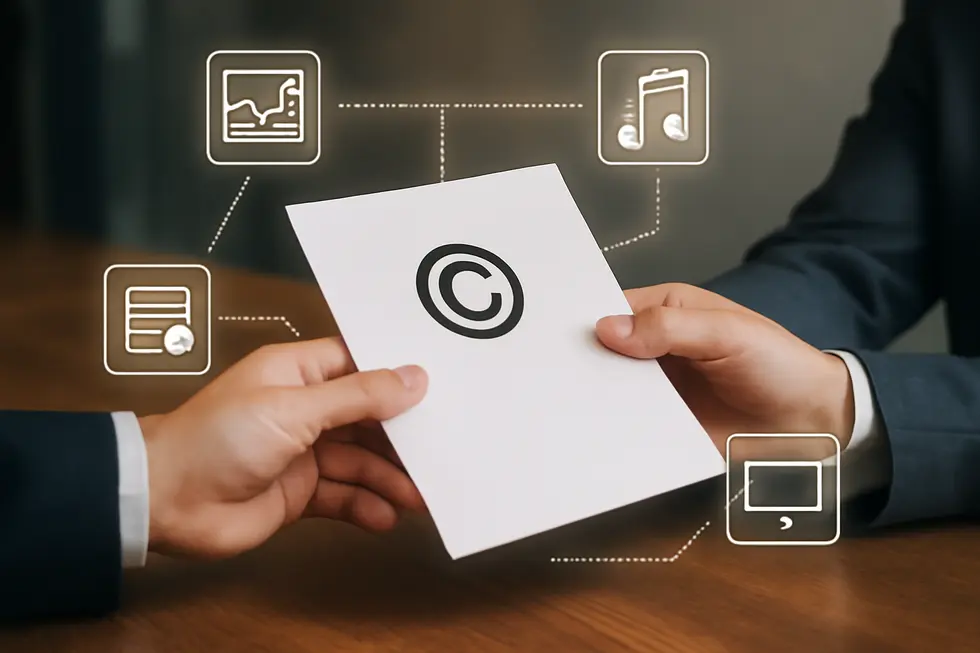
1. Harnessing Technology in Licensing: Software Protection and Digital Rights Management
The evolving digital landscape has introduced distinctive technological approaches to enforce copyright through licensing, especially in software and digital content. Software licensing uses tools like login-based systems, license keys, and online activation to authenticate users and regulate access. These methods enable adaptable models such as subscriptions and pay-per-use, while offering robust usage analytics. Physical dongles, once common, are declining due to logistical challenges, yet they historically provided tangible enforcement. Copyright in software arises automatically with its original expression, but registering it enhances legal enforcement, particularly in global contexts governed by treaties like the Berne Convention.
Digital Rights Management (DRM) implements software-based controls to prevent unauthorized copying and distribution of digital works. Supported by laws such as the DMCA, DRM restricts circumvention, though it can sometimes limit legitimate uses like accessibility or cross-platform interoperability. In response, some open-source licenses oppose overly restrictive DRM to preserve user freedoms.
Licensing agreements reflect these technologies by granting rights holders the ability to control reproduction, distribution, and adaptation of their works while balancing permitted uses under fair use doctrines. Modern licensing increasingly incorporates flexible terms that consider emerging digital realities, including AI-driven applications. Together, these technological licensing mechanisms ensure efficient, scalable, and enforceable copyright protection tailored to the complexities of digital software and media.
For an in-depth guide on software license enforcement technologies, visit: https://www.10duke.com/learn/software-licensing/software-license-enforcement/.
Explore more about copyright’s economic and legal aspects in digital contexts at copyright definition economics business.
2. Exclusive vs. Non-Exclusive Licenses: Economic Impacts and Market Dynamics in Copyright Licensing
Copyright licensing shapes how creative works generate economic value and influence markets through exclusive and non-exclusive arrangements. An exclusive license grants a single party the sole right to exploit a copyrighted work in a specific territory or field, effectively creating a temporary monopoly. This exclusivity encourages the licensee to invest heavily in marketing, distribution, and development, as fewer competitors dilute their returns. Consequently, licensors often command higher fees or royalties for exclusive licenses, sacrificing the ability to license others in the same domain but securing more focused exploitation.
Conversely, non-exclusive licenses permit multiple users to access and use the work simultaneously. This model expands market reach and fosters broader cultural dissemination, enabling licensors to diversify income streams and reduce reliance on a single partner. However, these licenses typically yield lower fees per licensee, since each faces competition and shares market benefits. The trade-off for licensors is between concentrated control and broad market penetration, while licensees face less incentive for large investment compared to exclusive rights.
From an economic perspective, copyright’s exclusive rights serve as a temporary monopoly to stimulate creation by regulating reproduction and distribution. Licensing transforms these rights into flexible market tools, balancing investment incentives against risk and reach. Especially in digital and interactive media, where copying and remixing challenge exclusivity enforcement, rightsholders often adopt adaptive strategies blending exclusivity with openness.
Strategically, defining territorial scope, duration, and permitted uses within licenses allows for tailored approaches optimizing economic returns amid shifting technology and competition. For deeper analysis of related licensing economic principles, see cross-border patent licensing insights here. For additional foundational knowledge on copyright concepts relevant to licensors and licensees, explore this detailed copyright information for businesses.
3. Navigating Compulsory and Statutory Licensing: Legal and Geopolitical Dynamics in Copyright
Compulsory and statutory licensing are essential legal frameworks that blur the line between creators’ exclusive rights and public access needs. These mechanisms enable authorized entities or governments to permit use of copyrighted works without direct permission from copyright holders, often to serve the broader public interest or prevent rights from being withheld unfairly. While compulsory licensing is generally invoked when the copyright owner refuses to license or fails to make the work readily available, statutory licensing operates through specific laws that set standardized royalty conditions, facilitating mass use in sectors like broadcasting. For instance, statutory licenses simplify usage for radio and television networks, balancing efficient access with fair creator compensation through government-determined royalties. The application and scope of these licenses vary widely due to geopolitical influences, economic priorities, and differing national legal traditions. International treaties seek harmonization but still allow significant national discretion, leading to diverse enforcement and licensing landscapes. Countries may leverage these frameworks strategically within trade and cultural policies, impacting multinational intellectual property management. Legally, these licenses represent a delicate equilibrium—ensuring copyrighted works are accessible while safeguarding creators’ rights via transparent royalty frameworks and clear criteria such as refusal to license or public interest safeguards. Understanding these mechanisms reveals how copyright law interfaces with societal needs and global dynamics in licensing and rights management. For deeper context on copyright’s business implications, see copyright information example business.
For further exploration, consult the Indian Copyright Act, 1957, Sections 31, 31A, 32, and its 2012 amendment addressing statutory licensing.
4. Navigating Copyright Licensing’s Societal Role: Access, Cultural Flow, and Public Benefit
Copyright licensing mechanisms profoundly shape how society accesses and interacts with creative works, influencing cultural exchange and public interest outcomes. Restrictive licenses, often laden with complex terms, can severely limit knowledge sharing, especially in academic and heritage sectors where open access is paramount. These barriers complicate international collaboration and slow the circulation of cultural and educational content. In contrast, more adaptable licensing models, such as those incorporating fair use exceptions or collaborative frameworks, promote accessibility by allowing transformative uses like remixes and memes—creative practices vital to modern digital culture.
Moreover, the traditional copyright emphasis on control sometimes clashes with the dynamic nature of new media, where creativity thrives on sharing and adaptation. Overzealous enforcement may push creators to avoid copyrighted material, favoring public domain or permissively licensed content, thus reshaping cultural production channels. Licensing systems that encourage cooperation between rights holders and creators foster richer, more diverse cultural outputs without compromising intellectual property.
Balancing creator rights with public good is central to public interest licensing. Excessive commercialization risks eclipsing non-commercial values like moral rights and open academic dialogue. Tools such as DMCA takedown notices play a dual role: while protecting creators, when applied thoughtfully, they support legal creativity and user engagement on digital platforms.
Overall, the societal impact of copyright licensing depends on thoughtful design that maintains creator respect alongside broad cultural participation. More transparent and flexible licensing frameworks better serve the evolving needs of education, innovation, and cultural exchange.
For deeper insights on balancing copyright protection with creative freedom on digital platforms, see this analysis of DMCA takedowns.
Chapter 3: Navigating Copyright Licensing: Exclusive and Non-Exclusive Rights in Creative Works
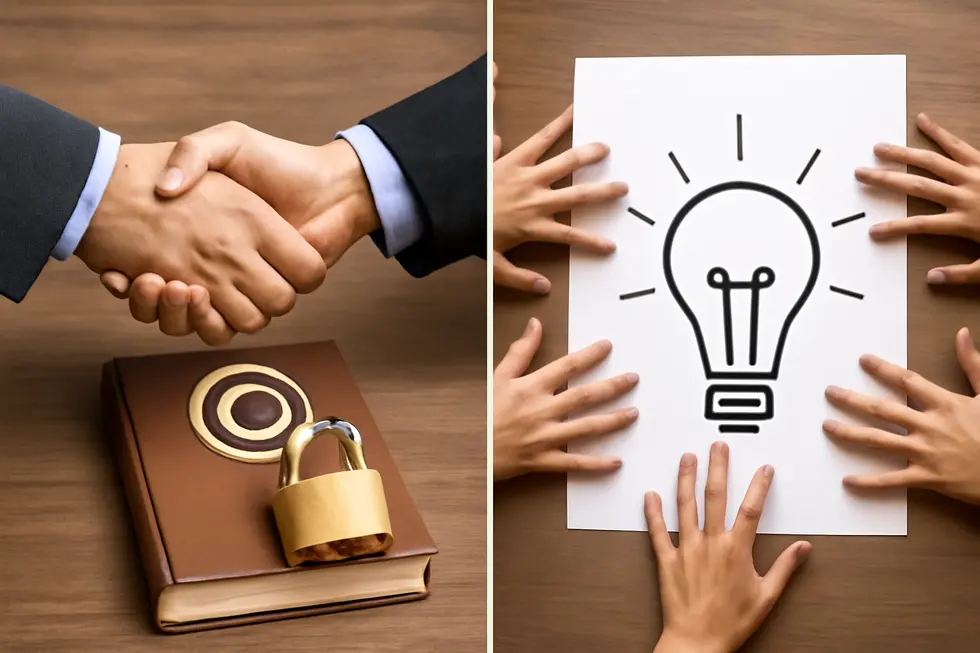
1. How Technological Advances Shape Exclusive and Non-Exclusive Copyright Licensing
Exclusive and non-exclusive licenses shape the technological landscape of copyrighted works by defining how these creations are used, shared, and evolved. An exclusive license grants a sole licensee comprehensive rights over a work’s use or commercialization within certain markets or fields. This exclusivity often motivates concentrated investment and deep development, as the licensee enjoys a competitive edge and control over derivative innovations. However, it also restricts broader collaboration and usage by other parties, since the licensor cannot use the work without permission from the licensee.
Conversely, non-exclusive licenses enable multiple parties to access, adapt, and commercialize a work simultaneously. This model encourages a broader diffusion of technology and creative content, accelerating innovation through shared contributions and diverse applications. By retaining ownership, licensors maintain flexibility to license additional uses or territories to others, fostering dynamic ecosystems of collaborative development. Yet, clear contractual terms are essential to navigate challenges around rights to derivative works and improvements.
The technological implications of these licensing forms also extend to market reach and legal considerations. Exclusive licenses deliver focused, high-value partnerships but may face scrutiny for limiting competition. Non-exclusive licenses improve market penetration and lower antitrust risks by enabling multiple actors to participate. Particularly in cutting-edge fields like AI, licensing agreements must explicitly address rights over AI-generated derivative works to protect intellectual property and stimulate responsible innovation.
Understanding these nuances is crucial for creators and businesses managing copyright in an increasingly complex technological environment. For further insight into how licensing drives innovation, see this patent licensing role in innovation resource.
2. Economic Dynamics Behind Exclusive and Non-Exclusive Copyright Licenses
The economic landscape shaped by exclusive and non-exclusive copyright licenses reveals distinct advantages and trade-offs in monetization and market influence. Exclusive licenses confer a monopoly to a single licensee, who gains powerful market control and often pays higher royalties, reflecting the privilege of sole exploitation. This exclusivity motivates substantial investments in marketing and development, enabling strategic positioning and often resulting in upfront fees or premium royalty structures. However, such concentrated control carries antitrust risks, especially if it limits competitive access.
Conversely, non-exclusive licenses open the door to multiple simultaneous users, typically yielding lower royalty rates individually but expanding total revenue through volume. This model fosters broader dissemination, encourages diverse innovation, and supports wider market participation by lowering access barriers. It is especially beneficial in fields where mass accessibility drives value, such as education and software, allowing more creators and businesses to build upon original works. The lower legal friction associated with non-exclusive arrangements also reduces regulatory concerns.
Selecting between these licensing models hinges on balancing financial goals, desired control, and competitive dynamics within the market. Exclusive licensing can maximize immediate returns and exclusivity advantages, while non-exclusive approaches nurture broader innovation and economic engagement. Together, these forms illustrate how copyright’s flexible licensing mechanisms underpin the creative economy’s diverse needs and objectives.
For deeper insights on how copyright economic incentives function, see Copyright Definition Economics Business.
3. Global Dynamics Shaping Exclusive and Non-Exclusive Copyright Licenses
The intricacies of copyright licensing unfold profoundly within geopolitical frameworks, where exclusive and non-exclusive licenses navigate complex international landscapes. Exclusive licenses offer singular control to a licensee but face substantial enforcement challenges across borders due to divergent national laws and political climates. On the other hand, non-exclusive licenses grant access to multiple users simultaneously, facilitating wider dissemination but complicating consistent enforcement amid varying jurisdictions.
Economic priorities and trade policies heavily influence how licenses are negotiated and protected globally. Nations integrate copyright considerations within trade agreements to bolster domestic creative industries and curb piracy, balancing protection with openness. Legal and cultural differences lead to distinctive frameworks that shape territorial scope and rights enforcement, compelling licensors to tailor agreements carefully.
Political tensions and alliances further affect licensing strategies. Changes in diplomatic relations or IP regimes in key markets prompt multinational firms to shift between exclusive control and flexible non-exclusive arrangements based on risk and opportunity. Additionally, advancing technologies disrupt traditional licensing boundaries, introducing new models like machine-readable licenses for AI training data that address concerns around data sovereignty and fair use across nations.
In this global context, copyright enforcement transcends legal formalities and becomes entwined with economic diplomacy and cultural values. The choice between exclusive and non-exclusive licensing strategies reflects a nuanced response to these geopolitical currents shaping international commerce and creative exchange.
Learn more about foundational copyright principles in the context of business at copyright information example business.
External resource: Relationship between copyright and trade agreements managing piracy and protection.
4. How Exclusive and Non-Exclusive Copyright Licenses Shape Creativity, Access, and Economy
Exclusive and non-exclusive copyright licenses each play pivotal roles in shaping society’s relationship with creative works. An exclusive license grants sole rights to one party, creating a controlled environment where the licensee holds strong influence over the work’s use and distribution. This exclusivity often encourages significant investment and deeply nurtured development, as the licensee is assured return on their resources. However, such tight control may limit broader innovation and reduce the availability of the work to the public, concentrating cultural influence in fewer hands.
Conversely, non-exclusive licenses promote wider access and collaborative creativity by allowing multiple users to simultaneously build from or adapt a work. This model fosters diversity in derivative creations and greater dissemination, especially useful in educational and social contexts. The trade-off lies in managing consistency and quality, as the copyright owner must carefully oversee how the work is used to prevent dilution or fragmentation.
Economically, exclusive licenses focus revenue generation through a single channel, often driving higher immediate income and comprehensive commercialization. Non-exclusive arrangements diversify income sources, granting the copyright holder financial stability through multiple partnerships and reducing dependence on any one user’s performance.
In the evolving digital landscape, licensing clarity empowers users and creators alike, simplifying legal boundaries and encouraging responsible content adaptation. Nonetheless, each form carries risks: exclusive licenses may result in underexploited potential if licensees falter, while broad non-exclusive licensing risks compromising future commercial opportunities if not precisely managed.
This balance between control, accessibility, and innovation underscores the societal impact of licensing strategies, influencing cultural development and economic vitality. For deeper insights into copyright’s economic and legal frameworks, refer to this detailed copyright definition and economics overview.
Chapter 4: The Role of Creative Commons and Copyleft Licenses in Modern Copyright Frameworks
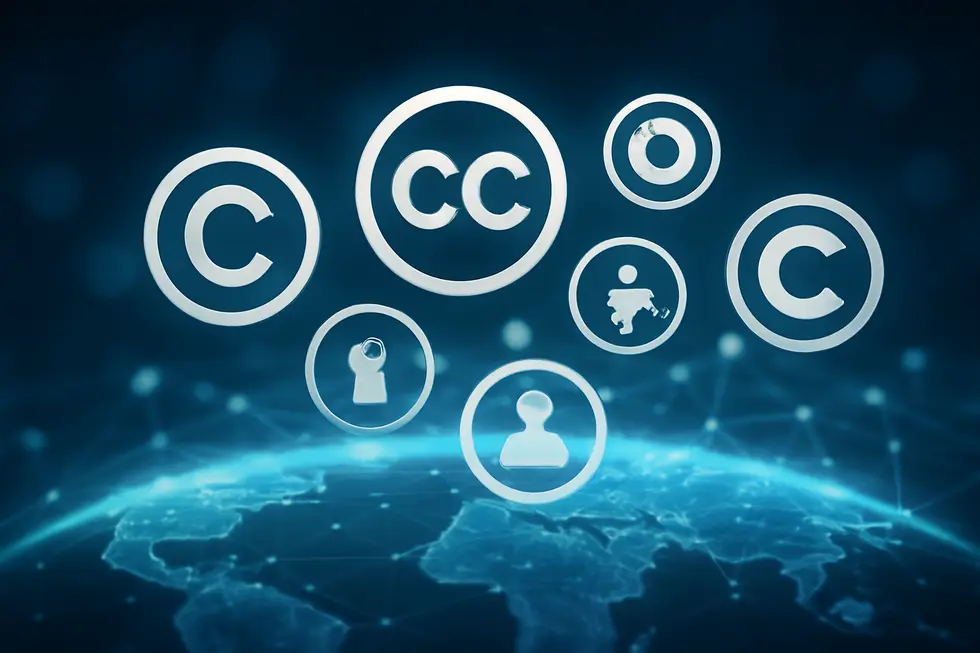
1. Technological Insights into Creative Commons and Copyleft Licensing Models
Creative Commons and copyleft licenses provide pivotal frameworks that balance copyright protection with the encouragement of sharing and innovation. Creative Commons licenses give creators a flexible toolkit, allowing them to specify how others may use their works—from full attribution requirements with broad reuse to stricter controls prohibiting commercial use or derivative creations. This system enables creators to maintain copyright while fostering an ecosystem of lawful, automated content sharing and remixing, especially critical in digital and educational environments. Their embedded metadata and rights management tools help streamline license visibility and compliance across online platforms.
Conversely, copyleft licenses emphasize preserving users’ freedoms through a strong reciprocity mechanism. Originating mainly in the software field, licenses like the GNU GPL require that any modified or derived work remain under the same or a compatible license. This legal-technological safeguard prevents proprietary enclosure of community-driven innovations, ensuring ongoing openness and collaboration. Tools integral to software development—such as version control systems and open repositories—work closely with copyleft licensing to enforce these conditions, supporting interoperability and counteracting restrictive technologies.
Together, these approaches exemplify how technological infrastructure intertwines with licensing models to shape copyright use. Creative Commons licenses offer tailored openness across diverse creative forms, while copyleft licenses enforce a uniform openness in software and related works. Both contribute significantly to the evolving landscape of digital intellectual property, enabling creators and users to engage flexibly within legal frameworks that promote sharing without sacrificing fundamental rights.
For further insights into the landscape of copyright law, including how licensing supports open content, see this detailed discussion on copyright language and business implications.
2. Balancing Innovation and Incentives: Economic Effects of Creative Commons and Copyleft Licensing
Creative Commons and Copyleft licenses reshape traditional economic models associated with copyright by redefining how creators, users, and markets interact. These licenses offer a spectrum of permissions that influence creators’ ability to monetize their works while encouraging broader societal benefits through enhanced access. For example, permissive Creative Commons licenses such as CC-BY allow commercial use with attribution, enabling creators to maintain revenue streams while expanding their audience. Conversely, licenses like CC-BY-NC restrict commercial exploitation, prioritizing open access and cultural dissemination but potentially limiting direct financial incentives.
Copyleft licenses, particularly prevalent in software, impose a reciprocal requirement that derivative works inherit the same licensing terms. This reciprocity fosters collaborative innovation and curtails monopolistic dominance. However, businesses seeking proprietary advantage might hesitate to invest, impacting commercialization and market investment.
The economic outcomes of these licensing frameworks hinge on balancing creator incentives with public accessibility. Open licenses accelerate knowledge diffusion and support education, research, and cultural enrichment, often enhancing indirect economic activity and innovation beyond immediate financial returns. Models like CC0, which dedicate works to the public domain, maximize reuse and societal gains. Yet, these openness benefits require alternative sustainability approaches since direct revenue can diminish.
Understanding how different license terms apply across industries—from software development to cultural heritage—clarifies that no single model fits all. Striking this balance is crucial, as highlighted in the nuanced interplay of economic and societal value generated by Creative Commons and Copyleft licensing. For a deeper perspective on copyright economics in a business context, consider exploring copyright definition economics business.
For further insight, see the analysis of open access benefits at Creative Commons: https://creativecommons.org/2025/09/10/understanding-barriers-to-accessing-heritage/
3. Global Legal Landscapes and Geopolitical Impact of Creative Commons and Copyleft Licensing
Creative Commons (CC) and copyleft licenses shape copyright through a distinctive blend of legal frameworks and geopolitical influences. Legally, these licenses create enforceable permissions governing the reuse, adaptation, and redistribution of creative works worldwide. For instance, the CC Attribution-ShareAlike (CC BY-SA) license mandates that derivative works remain under the same terms, preserving the original freedoms much like copyleft licenses widely used in software, such as the GPL. This legal structure ensures derivative creativity remains free and openly accessible, preventing proprietary restrictions on shared content. The spectrum of CC licenses allows creators to calibrate protections, from permitting commercial use and adaptations to restricting derivatives and commercial exploitation.
On the geopolitical front, copyright enforcement tied to these licenses interacts with complex international economic policies and political interests. Countries rely on copyright protection to support creative industries vital to their economies, influencing trade agreements and diplomatic negotiations. Multinational organizations must navigate a diverse patchwork of national laws when applying CC and copyleft licenses, which vary in their recognition and enforcement effectiveness. This global diversity challenges the harmonization of intellectual property rights but also fosters innovation by enabling cross-border collaboration under uniform licensing principles.
These dynamics underscore the role of CC and copyleft licenses not only as legal tools but as instruments embedded in broader geopolitical strategies affecting global knowledge exchange and cultural development. For a comprehensive overview of CC licenses and their legal nuances compared to copyleft, see the Washington University Becker Guides.
4. How Creative Commons and Copyleft Shape Cultural Sharing and Innovation
Creative Commons (CC) and copyleft licenses revolutionize cultural exchange and creative collaboration by redefining access to copyrighted works. Rather than enforcing rigid ‘all rights reserved’ barriers, CC licenses empower creators to control how others can reuse, adapt, or distribute their work. This flexibility nurtures a global environment of sharing, accelerating educational growth and inspiring innovation. Creators can select licenses ranging from permissive to more restrictive, enabling tailored permissions that encourage lawful creative freedom.
Copyleft licensing extends this openness by ensuring derivative works remain freely accessible under identical terms, preserving rights downstream and reinforcing open knowledge ecosystems. This approach counters the exclusivity often seen with traditional copyright, which can centralize control in large corporations and prioritize commercially viable yet culturally narrow content. As a result, CC and copyleft models combat cultural homogenization by supporting diverse voices and unique local expressions.
Despite their promise, challenges persist. Even works in the public domain face obstacles when institutions impose restrictive licenses or pseudo-copyrights on digital reproductions of cultural artifacts. These measures limit equitable access and reuse, impeding the democratization of heritage and creativity.
In balancing protection and openness, Creative Commons and copyleft licenses play a vital role in promoting cultural diversity and shared innovation worldwide. Yet, ongoing attention to access barriers is essential to ensure all communities benefit from this evolving landscape.
For a deeper exploration of barriers in public domain heritage access, see Understanding Barriers to Accessing Heritage.
Final thoughts
Copyright is a multifaceted tool that protects a broad spectrum of creative works vital to business success. Recognizing the different forms copyright protection covers—from literary works and software to audiovisual content and architectural designs—enables businesses to assert control over their intellectual assets. Complementing these protections are licensing mechanisms that dictate how rights are delegated or retained, with exclusive and non-exclusive models offering contrasting strategic advantages. Moreover, Creative Commons and Copyleft licenses provide flexible frameworks for controlled sharing and collaborative innovation in an interconnected business environment. By mastering these different forms of copyright and licensing, business owners can safeguard their creative investments while unlocking new pathways for value creation, distribution, and partnership. This holistic understanding is essential for leveraging intellectual property as a dynamic asset fundamental to sustainable business growth.
Your IP is the foundation of your success – let’s protect it together before it’s too late. We can’t wait to help you turn your ideas into legally secured assets.
About us
undefined
